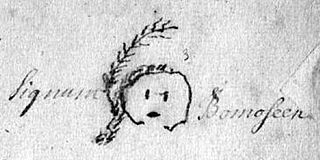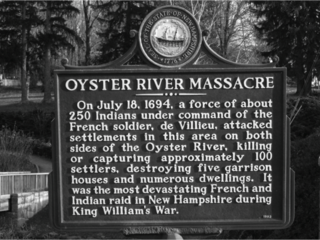
Queen Anne's War (1702–1713) was the second in a series of French and Indian Wars fought in North America involving the colonial empires of Great Britain, France, and Spain; it took place during the reign of Anne, Queen of Great Britain. In the United States, it is regarded as a standalone conflict under this name. Elsewhere it is usually viewed as the American theater of the War of the Spanish Succession. It is also known as the Third Indian War. In France it was known as the Second Intercolonial War.

King William's War was the North American theater of the Nine Years' War (1688–1697), also known as the War of the Grand Alliance or the War of the League of Augsburg. It was the first of six colonial wars fought between New France and New England along with their respective Native allies before France ceded its remaining mainland territories in North America east of the Mississippi River in 1763.

Norridgewock was the name of both an Indigenous village and a band of the Abenaki Native Americans/First Nations, an Eastern Algonquian tribe of the United States and Canada. The French of New France called the village Kennebec. The tribe occupied an area in the interior of Maine. During colonial times, this area was territory disputed between British and French colonists, and was set along the claimed western border of Acadia, the western bank of the Kennebec River.

Dummer's War (1722–1725) was a series of battles between the New England Colonies and the Wabanaki Confederacy, who were allied with New France. The eastern theater of the war was located primarily along the border between New England and Acadia in Maine, as well as in Nova Scotia; the western theater was located in northern Massachusetts and Vermont in the frontier areas between Canada and New England.

Samuel Shute was an English military officer and royal governor of the provinces of Massachusetts and New Hampshire. After serving in the Nine Years' War and the War of the Spanish Succession, he was appointed by King George I as governor of Massachusetts and New Hampshire in 1716. His tenure was marked by virulent disagreements with the Massachusetts assembly on a variety of issues, and by poorly conducted diplomacy with respect to the Native American Wabanaki Confederacy of northern New England that led to Dummer's War (1722–1725).

Sébastien Rale was a French Jesuit missionary and lexicographer who preached amongst the Abenaki and encouraged their resistance to British colonization during the early 18th century. This encouragement culminated in Dummer's War (1722–1725), where Rale was killed by a group of New England militiamen. Rale also worked on an Abenaki-French dictionary during his time in North America.

The Battle of Port Royal occurred at Port Royal, the capital of Acadia, during King William's War. A large force of New England provincial militia arrived before Port Royal. The Governor of Acadia Louis-Alexandre des Friches de Menneval had only 70 soldiers; the unfinished enceinte remained open and its 18 cannon had not been brought into firing positions; 42 young men of Port-Royal were absent. Any resistance therefore appeared useless. Meneval surrendered without resistance not long after the New Englanders arrived. The New Englanders, led by Sir William Phips, after alleging Acadian violations of the terms of surrender, plundered the town and the fort.

The Treaty of Portsmouth, signed on July 13, 1713, ended hostilities between the Eastern Abenakis, a Native American tribe and First Nation and Algonquian-speaking people, with the British provinces of Massachusetts Bay and New Hampshire. The agreement renewed a treaty of 1693 the natives had made with Governor Sir William Phips, two in a series of attempts to establish peace between the Wabanaki Confederacy and colonists after Queen Anne's War.

Fort William Henry is located in the village of New Harbor in the town of Bristol, Maine. The fort was, in its time, the largest in New England. The fort was originally built in 1692 but destroyed four years later by New France in the Siege of Pemaquid (1696). A reconstruction was built in 1908. The fort was added to the National Register of Historic Places on December 1, 1969. Fort William Henry is now operated as a museum about the fort's history.

The Raid on Oyster River, also known as the Oyster River Massacre, happened during King William's War, on July 18, 1694, when a group of Abenaki and some Maliseet, directed by the French, attacked an English settlement at present-day Durham, New Hampshire.

The siege of Pemaquid was a successful attack by a large band of Abenaki Indians on the English fort at Pemaquid, Fort Charles, then the easternmost outpost of colonial Massachusetts. The French-Abenaki attack was led by Jean-Vincent d'Abbadie de Saint-Castin and Father Louis-Pierre Thury and Chief Moxus. The fall of Pemaquid was a significant setback to the English. It pushed the frontier back to Casco (Falmouth), Maine.

The Battle of Norridgewock was a raid on the Abenaki settlement of Norridgewock by a group of colonial militiamen from the New England Colonies. Occurring in contested lands on the edge of the American frontier, the raid resulted in a massacre of the Abenaki inhabitants of Norridgewock by the militiamen.
The Northeast Coast campaign was the first major campaign by the French of Queen Anne's War in New England. Alexandre Leneuf de La Vallière de Beaubassin led 500 troops made up of French colonial forces and the Wabanaki Confederacy of Acadia. They attacked English settlements on the coast of present-day Maine between Wells and Casco Bay, burning more than 15 leagues of New England country and killing or capturing more than 150 people. The English colonists protected some of their settlements, but a number of others were destroyed and abandoned. Historian Samuel Drake reported that, "Maine had nearly received her death-blow" as a result of the campaign.
The Northeast Coast campaign (1723) occurred during Father Rale's War from April 19, 1723 – January 28, 1724. In response to the previous year, in which New England attacked the Wabanaki Confederacy at Norridgewock and Penobscot, the Wabanaki Confederacy retaliated by attacking the coast of present-day Maine that was below the Kennebec River, the border of Acadia. They attacked English settlements on the coast of present-day Maine between Berwick and Mount Desert Island. Casco was the principal settlement. The 1723 campaign was so successful along the Maine frontier that Dummer ordered its evacuation to the blockhouses in the spring of 1724.

The Maliseet militia was made up of warriors from the Maliseet of northeastern North America. Along with the Wabanaki Confederacy, the French and Acadian militia, the Maliseet fought the British through six wars over a period of 75 years. They also mobilized against the British in the American Revolution. After confederation, Maliseet warriors eventually joined Canada's war efforts in World War I and World War II.
The Battle of Falmouth was fought at Falmouth, Maine when the Canadiens and Wabanaki Confederacy attacked the English New Casco Fort. The battle was part of the Northeast Coast Campaign (1703) during Queen Anne's War.
The Northeast Coast campaign of 1750 occurred during Father Le Loutre's War from 11 September to December 1750. The Norridgewock as well as the Abenaki from St. Francois and Trois-Rivières, Quebec raided British settlements along the Acadia/ New England border in present-day Maine.
The Northeast Coast campaign of 1675 was conducted during the First Abenaki War and involved the Wabanaki Confederacy raiding colonial American settlements along the New England Colonies/Acadia border in present-day Maine. Allied with French colonists in New France, they killed eighty colonists and burned many farms, blunting the tide of colonial British expansion in the north. Settlers deserted community after community, leaving only the settlements south of the Saco River to maintain an English presence in the region. Historian Georges Cerbelaud Salagnac writes, that Castine and the Abenaki “displayed consummate skill at it, holding in check at every point, from the Penobscot River to Salmon Falls, N.H., and even beyond, 700 regular troops, and even inflicting humiliating defeats upon them.” These raids were part of continuing warfare as the French and British fought for control in North America into the 18th century, as part of their rivalry in Europe.
The Northeast Coast campaign of 1677 was conducted during the First Abenaki War and involved the Wabanaki Confederacy raiding colonial American settlements along the New England Colonies/Acadia border in present-day Maine. The Wabanaki killed and captured colonists and burned many farms, blunting the tide of colonial American expansion.
The First Abenaki War was fought along the New England/Acadia border primarily in present-day Maine. Richard Waldron and Charles Frost led the forces in the northern region, while Jean-Vincent d'Abbadie de Saint-Castin worked with the tribes that would make up the Wabanaki Confederacy. The natives engaged in annual campaigns against the English settlements in 1675, 1676, and 1677. Waldron sent forces so far north that he attacked the Mi'kmaq in Acadia.











